CONTAINERS are big business, a business that will get bigger.
Page 119

Page 120
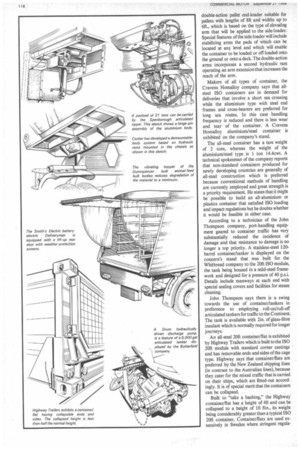
Page 121
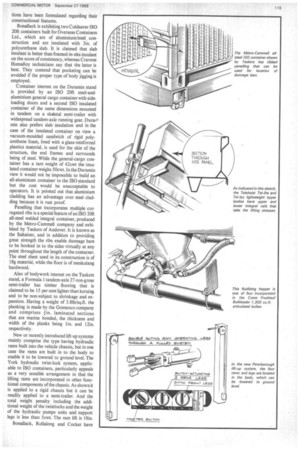
Page 122
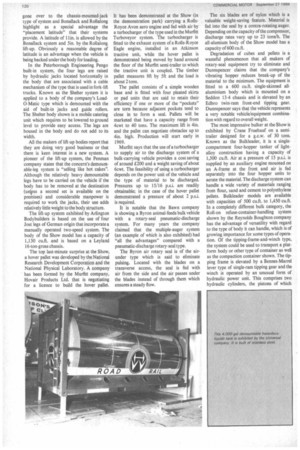
Page 126

Page 127
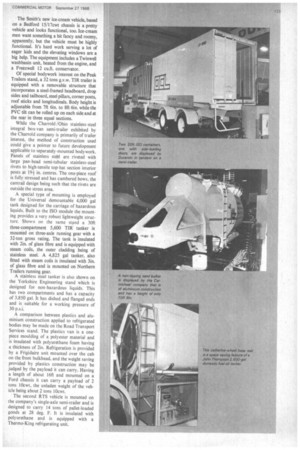
Page 128
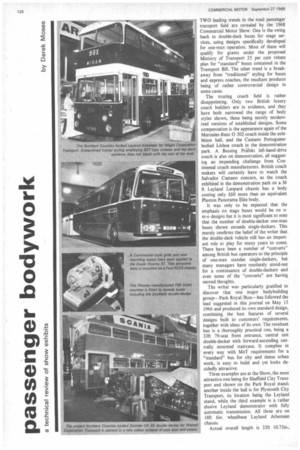
Page 129
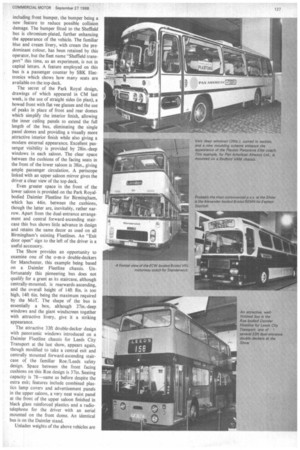
Page 130
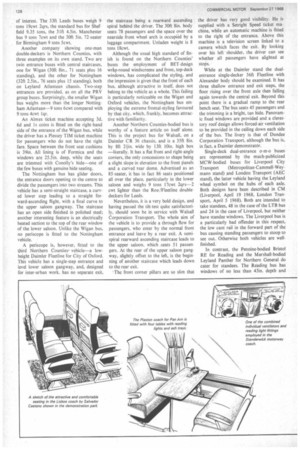
Page 131
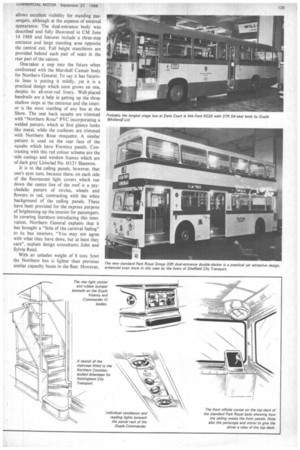
Page 132
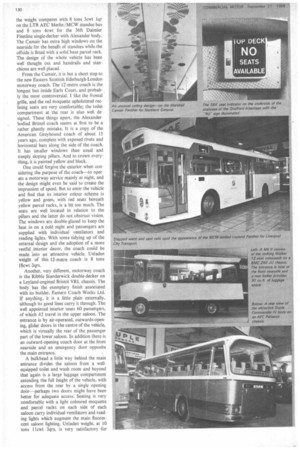
Page 133

If you've noticed an error in this article please click here to report it so we can fix it.
To many operators visit ing the Show this is an unpalatable thought, but it is one that they will have to live with. Even those operators who are directly interested in tippers, box vans, low-loaders or mobile shops (and nothing but tippers, box vans, low-loaders or mobile shops) are paying some attention to containers. One day they might have to make containers their business too!
But for all that the Show abounds in bodywork that appeals to operators who have made a success of using special bodies that meet their special needs and who are going to go on doing it that way. And to those who want something only a bit special like a lightweight platform body that can be put on the kind of chassis they prefer and give them more payload. Or are looking for an easy way of moving loads around the depot or vehicle floor—such as a hover pallet that they'll soon be able to buy and can be operated by air supplied by an engine turbocharger.
The lift-off body has been with us for a long time now in various forms—too many forms perhaps. When will a system be evolved that is acceptable all round and will enable cost-saving standardization to be applied— as should ideally happen with containers?
Standardization or specialization? There are some rugged individualists left amongst hauliers who want a plain timber/steel body (with a slogging engine up front) and who will continue to deliver anything anywhere on time if the MoT doesn't interfere. To them standardization and specialization arc dirty words. But they'll get some good ideas at the Show, too.
A close look at containers at the Show reveals that aluminium-and-steel and all-steel types of construction predominate, notably of course for ISO containers. But Volvo says that containers with aluminium framing and corner castings, panelled in plastics-covered plywood, are the coming thing. No such container is exhibited on the company's stand, but full details are available of Parator containers of this type that are built by an associated company to ISO standards. All-important advantages claimed for the construction include resistance to damage and ease of repair in addition to low weight. A spokesman of Highway Trailers could be found who agrees with this, but he points out that Sweden has a lot of cheap timber around the place.
The container shown on the Volvo stand is an Interconsult 20ft all-steel type having a tare weight of around 1 ton 16cwt, whereas the tare weight of the Parator container is 1 ton lOcwt. A four-ply plywood is used for the roof of the Parator and the sides are of eight-ply material. Dunnage bars are included in the equipment and special provision is made for lashing belts. Collapsible steel containers with fold-down ends of plywood or metal are included in the Parator range.
The Parator company produces an hydraulically-operated container side-loader (exhibited at the Glasgow Show last year) and at Earls Court details are obtainable on the Sheppard Fabrications stand of a rather similar side-loader that will shortly be available. Illustrations are displayed of a Sheppard double-action pallet end-loader suitable for pallets with lengths of 8ft and widths up to 6ft., which is based on the type of elevating arm that will be applied to the side-loader. Special features of the side-loader will include stabilizing arms the pads of which can be located at any level and which will enable the container to be loaded or off-loaded onto the ground or onto a deck. The double-action arms incorporate a second hydraulic ram operating an arm extension that increases the reach of the arm.
Makers of all types of container, the Cravens Homalloy company says that allsteel ISO containers are in demand for deliveries that involve a short sea crossing while the aluminium type with steel end frames and cross-bearers are preferred for long sea routes. In this case handling frequency is reduced and there is less wear and tear of the container. A Cravens Homalloy aluminium/steel container is exhibited on the company's stand.
The all-steel container has a tare weight of 2 tons, whereas the weight of the aluminium/steel type is 1 ton 14.4cwt. A technical spokesman of the company reports that non-standard containers produced for newly developing countries are generally of all-steel construction which is preferred because conventional methods of handling are currently employed and great strength is a priority requirement. He states that it might be possible to build an all-aluminium or plastics container that satisfied ISO loading and impact regulations but he doubts whether it would be feasible in either case.
According to a technician of the John Thompson company, port-handling equipment geared to container traffic has very substantially reduced the incidence of damage and that resistance to damage is no longer a top priority. A stainless-steel 120barrel container/tanker is displayed on the concern's stand that was built for the Whitbread company to the 20ft ISO module, the tank being housed in a mild-steel framework and designed for a pressure of 40 p.s.i. Details include manways at each end with special sealing covers and facilities for steam cleaning.
John Thompson says there is a swing towards the use of container/tankers in preference to employing roll-on/roll-off articulated tankers for traffic to the Continent. The tank is available with 2in. of glass-fibre insulant which is normally required for longer journeys.
An all-steel 20ft container/flat is exhibited by Highway Trailers which is built to the ISO 20ft module with standard corner castings and has removable ends and sides of the cage type. Highway says that container/flats are preferred by the New Zealand shipping lines (in contrast to the Australian lines), because they cater for the mixed traffic that is carried on their ships, which are fitted-out accordingly. It is of special merit that the containers can be collapsed.
Built to "take a bashing," the Highway container/flat has a height of 4ft and can be collapsed to a height of 1ft Sin., its weight being considerably greater than a typical ISO 20ft container. Container/flats are used extensively in Sweden where stringent regula tions have been formulated regarding their constructional features.
Bonallack is exhibiting two Coldsaver ISO 20ft containers built for Overseas Containers Ltd., which are of aluminium/steel, construction and are insulated with 3in. of polyurethane slab. It is claimed that slab insulant is better than foamed-in-situ insulant on the score of consistency, whereas Cravens Homalloy technicians say that the latter is best. They contend that pocketing can be avoided if the proper type of body jigging is employed.
Container interest on the Duramin stand is provided by an ISO 20ft steel-andaluminium general cargo container with sideloading doors and a second ISO insulated container of the same dimensions mounted in tandem on a skeletal semi-trailer with widespread tandem-axle running gear. DuraA'y min also prefers slab insulation and in the case of the insulated container on view a vacuum-moulded sandwich of rigid polyurethane foam, lined with a glass-reinforced plastics material, is used for the skin of the structure, the end frames and surrounds being of steel. While the general-cargo container has a tare weight of 42cwt the insulated container weighs 50cwt. In the Duramin view it would not be impossible to build an all-aluminium container to the ISO standard but the cost would be unacceptable to operators. It is pointed out that aluminium cladding has an advantage over steel cladding because it is rust proof.
Panelling that incorporates multiple corrugated ribs is a special feature of an ISO 20ft all-steel welded integral container, produced by the Metro-Cammell company and exhibited by Taskers of Andover. It is known as the Saltainer, and in addition to providing great strength the ribs enable dunnage bars to be hooked in to the sides virtually at any point throughout the length of the container. The steel sheet used in its construction is of 18g material, while the floor is of menkulang hardwood.
Also of bodywork interest on the Taskers stand, a Formula 1 tandem-axle 27-ton-gross semi-trailer has timber flooring that is claimed to be 15 per cent lighter than keruing and to be non-subject to shrinkage and expansion. Having a weight of 3.81b/sq.ft. the planking is made by the Gomanco company and comprises lin, laminated sections that are marine bonded, the thickness and width of the planks being lin. and 12in. respectively.
New or recently introduced lift-up systems mainly comprise the type having hydraulic rams built into the vehicle chassis, but in one case the rams are built in to the body to enable it to be lowered to ground level. The York hydraulic twist-lock system, applicable to ISO containers, particularly appeals as a very sensible arrangement in that the lifting rams are incorporated in other functional components of the chassis. As shown it is applied to a rigid chassis but it can be readily applied to a semi-trailer. And the total weight penalty including the additional weight of the twistlocks and the weight of the hydraulic pumps units and support legs is less than 5cwt. The ram lift is I 8in.
Bonallack, Rollalong and Cocker have gone over to the chassis-mounted-jack type of system and BonaHack and Rol!along highlight as a special advantage the "placement latitude" that their systems provide. A latitude of 1 lin. is allowed by the Bonallack system and 5in, by the Rollalong lift-up. Obviously a reasonable degree of latitude is an advantage when the vehicle is being backed under the body for loading.
In the Peterborough Engineering Pengo built-in system, the four legs are raised by hydraulic jacks located horizontally in the body that are associated with a cable mechanism of the type that is used in fork-lift trucks. Known as the Shelter system it is applied to a body of the company's LoadO-Matic type which is demounted with the aid of built-in jacks and guide rollers. The Shelter body shown is a mobile catering unit which requires to be lowered to ground level to provide easy access. The legs are housed in the body and do not add to its width.
All the makers of lift-up bodies report that they are doing very good business or that there is keen interest in a new system. A pioneer of the lift-up system, the Penman company states that the concern's demountable-leg system is "selling like hot cakes". Although the relatively heavy demountable legs have to be carried on the vehicle if the body has to be removed at the destination (unipss a second set is available on the premises) and considerable manpower is required to work the jacks, their use adds relatively little weight to the body structure.
The lift-up system exhibited by Arlington Bodybuilders is based on the use of four Jost legs of German origin that incorporate a manually operated two-speed system. The body of the Show model has a capacity of 1,130 cu.ft. and is based on a Leyland 16-ton-gross chassis.
The top last-minute surprise at the Show, a hover pallet was developed by the National Research Development Corporation and the National Physical Laboratory. A company has been formed by the Murfitt company, Hovair Products Ltd. that is negotiating for a licence to build the hover pallet. It has been demonstrated at the Show (in the demonstration park) carrying a RollsRoyce Avon aero engine and fed with air by a turbocharger of the type used in the Murfitt Turboveyor system. The turbocharger is fitted to the exhaust system of a Rolls-Royce Eagle engine, installed in an Atkinson tractive unit, while the hover pallet is demonstrated being moved by hand around the floor of the Murfitt semi-trailer to which the tractive unit is coupled. The timber pallet measures 8ft by 5ft and the load is about 2 tons.
The pallet consists of a simple wooden base and is fitted with four pleated skirts or pad units that are said to retain their efficiency if one or more of the "pockets" are torn because adjacent pockets tend to close in to form a seal. Pallets will be marketed that have a capacity range from 4cwt to 40 tons. The maximum lift is 4in. and the pallet can negotiate obstacles up to 4in. high. Production will start early in 1969.
Murfitt says that the use of a turbocharger to supply air to the discharge system of a bulk-carrying vehicle provides a cost saving of around E200 and a weight saving of about 6cwt. The feasibility of using a turbocharger depends on the power unit of the vehicle and the type of material to be discharged. Pressures up to 15/16 p.s.i. are readily obtainable; in the case of the hover pallet demonstrated a pressure of about 2 p.s.i. is required.
It is notable that the Bawn company is showing a Byron animal-feeds bulk vehicle with a rotary-seal pneumatic-discharge system. For many years the company claimed that the multiple-auger system (an example of which is also exhibited) had "all the advantages" compared with a pneumatic-discharge rotary-seal type.
The Byron air rotary seal is of the airunder type which is said to eliminate pulsing. Located with the blades on a transverse access, the seal is fed with air from the side and the air passes under the blades instead of through them which ensures a steady flow.
The six blades are of nylon which is a valuable weight-saving feature. Material is fed into the seal by a contra-rotating auger. Depending on the capacity of the compressor, discharge rates vary up to 23 tons/h. The all-alumium body of the Show model has a capacity of 600 cu.ft.
Degradation of cubes and pellets is a wasteful phenomenon that all makers of rotary-seal equipment try to eliminate and Dunnspencer claims that the company's vibrating hopper reduces break-up of the material to the minimum. The equipment is fitted to a 600 cu.ft. single-skinned allaluminium body which is mounted on a Seddon 13-4 chassis and is elevated by an Edbro twin-ram front-end tipping gear. Dunnspencer says that the vehicle represents a very notable vehicle/equipment combination with regard to overall weight.
The most impressive bulker at the Show is exhibited by Crane Fruehauf on a semitrailer designed for a g.c.w. of 30 tons. Known as the Bulkleader, it is a singlecompartment four-hopper tanker of lightalloy construction having a capacity of 1,300 cu.ft. Air at a pressure of 15 p.s.i. is supplied by an auxiliary engine mounted on an A-frame at the front and air is fed separately into the four hopper units to aerate the material. The discharge system can handle a wide variety of materials ranging from flour, sand and cement to polyethylene pellets. Bulkleader models are available with capacities of 500 cu.ft. to 1,450 cu.ft. In a completely different bulk category, the Roll-on refuse-container-handling system shown by the Reynolds Boughton company has the advantage of versatility with regard to the type of body it can handle, which is of growing importance for some types of operation. Of the tipping-frame-and-winch type, the system could be used to transport a platform body or other type of container as well as the compaction container shown. The tipping frame is elevated by a Bennes-Marrel lever type of single-ram tipping gear and the winch is operated by an unusual form of hydraulic power unit. This comprises two hydraulic cylinders, the pistons of which drive a crank mechanism.
One of the most interesting design features of the glass-reinforced plastics 2,500gal max-section three-compartment tanker on the Always Welding stand is that it is flexibly mounted on Metalastik Metacone rubber bushes. The only non-plastics parts of the tanker comprise steel inserts in the mounting brackets which are moulded into the shell. Even the pipes are of plastics. The tanker will be used to carry domestic fuel and would be suitable for carrying derv. Although plastics tanks are employed on the Continent to transport petroleum spirit, this is not allowed in the U.K.
A particular problem involved in the design of a domestic fuel-oil tanker is created by the space occupied by the cabinet housing the hose reel and dispensing control units. A catherine-wheel hose reel is used by John Thompson on a 2,500gal tanker of this type (mounted on a Seddon 16-tons-gross chassis) which is mounted at the front of the tank and occupies the minimum of space. The dispensing controls and motor are housed in a small cabinet on the side, and it is claimed that this arrangement is the best with regard to space utilization. Of max-section, the tank is constructed of mild steel.
Getting the load distribution right often represents a particularly difficult problem in the case of a tipper and technicians of the Edbro group have good advice to give on the subject to any interested bodybuilder or operator. The centre of gravity of the load is all important and if overloading of one of the axles is to be avoided when the maximum rated load is being carried body size must be matched to hinge-pin position and the type of tipping gear used to give the optimum centre of gravity. Edbro can provide chapterand-verse on equipment and body variations applicable to all types of vehicle marketed in this country.
Many visitors are having the first opportunity at the Show to examine constructional details of the Telehoist Tel-lite high-tensilesteel lightweight tipper body (and its counterpart in aluminium, the Tel-Joy) the Autolifts/Anthony lightweight steel body and the Peterborough Engineering Pengo lightweight aluminium body. Technicians of Peterborough Engineering particularly emphasize that the method of welded construction employed enables bodies to be produced with lengths up to 28ft. They claim that it provides a weight saving, compared with conventional aluminium construction, of 124 per cent.
An articulated tipper that can carry about 800 cu.ft. of material and has an unladen weight of 4 tons 17cwt is news and the news can be found on the Spenborough stand. An all-aluminium body is mounted on a York trailer which is hauled by a Foden tractive unit and the unladen weight of the combination is 10 tons 19ewt. The vehicle is plated at 32 tons gross and can therefore carry a payload of 21 tons.
A Spenborough single-ram front-end tipping gear can elevate the body to an angle of 43deg and the system incorporates a threeposition control valve. Of unusual interest the tailboard is power operated by pneumatic rams. The Smith's new ice-cream vehicle, based on a Bedford 15/17cwt chassis is a pretty vehicle and looks functional, too. Ice-cream men want something a bit fancy and roomy, apparently, but the vehicle must be highly functional. It's hard work serving a lot of eager kids and the elevating windows are a big help. The equipment includes a Twinwell washbasin unit, heated from the engine, and a Freezwell 12 cult. conservator.
Of special bodywork interest on the Peak Trailers stand, a 32 tons g.v.w. TIR trailer is equipped with a removable structure that incorporates a steel-framed headboard, drop sides and tailboard, steel pillars, corner posts.
roof sticks and longitudinals. Body height is adjustable from 7ft 6in. to 8f1 6in. while the PVC tilt can be rolled up on each side and at the rear in three equal sections.
While the Charrold /Ohio stainless-steel integral box-van semi-trailer exhibited by
the Charrold company is primarily of trailer interest, the method of construction used could give a pointer to future development applicable to separately-mounted bodywork. Panels of stainless steel are riveted with large pan-head semi-tubular stainless-steel rivets to high-tensile top-hat section interior posts at 19+ in. centres. The one-piece roof is fully stressed and has cambered bows, the cantrail design being such that the rivets are outside the stress area.
A special type of mounting is employed for the Universal demountable 4,000 gal tank designed for the carriage of hazardous liquids. Built to the ISO module the mounting provides a very robust lightweight structure. Shown on the same stand a 30f1 three-compartment 5,600 T1R tanker is mounted on three-axle running gear with a 32-ton gross rating. The tank is insulated with 2in. of glass fibre and is equipped with steam coils, the outer cladding being of stainless steel. A 4,825 gal tanker, also fitted with steam coils is insulated with 3in. of glass fibre and is mounted on Northern Trailers running gear.
A stainless steel tanker is also shown on the Yorkshire Engineering stand which is designed for non-hazardous liquids. This has two compartments and has a capacity of 3,850 gal. It has dished and flanged ends and is suitable for a working pressure of 30 p.s.i.
A comparison between plastics and aluminium construction applied to refrigerated bodies may be made on the Road Transport Services stand. The plastics van is a onepiece moulding of a polyester material and is insulated with polyurethane foam having a thickness of 2in. Refrigeration is provided by a Frigidaire unit mounted over the cab on the front bulkhead, and the weight saving provided by plastics construction may be judged by the payload it can carry. Having a length of about 16ft and mounted on a Ford chassis it can carry a payload of 2 tons lOcwt. the unladen weight of the veh icle being about 2 tons 10cwt.
The second RTS vehicle is mounted on the company's single-axle semi-trailer and is designed to carry 14 tons of pallet-loaded goods at 28 deg. F. It is insulated with polyurethane and is equipped with a Thermo-King refrigerating unit. TWO leading trends in the road passenger transport field are revealed by the 1968 Commercial Motor Show. One is the swing back to double-deck buses for stage services, using designs specifically developed for one-man operation. Most of these will qualify for grants under the proposed Ministry of Transport 25 per cent rebate plan for "standard" buses contained in the Transport Bill. The other trend is a breakaway from "traditional" styling for buses and express coaches, the resultant products being of rather controversial design in some cases.
The touring coach field is rather disappointing. Only two British luxury coach builders are in evidence, and they have both narrowed the range of body styles shown, these being mostly modernized versions of established designs. Some compensation is the appearance again of the Mercedes-Benz 0 302 coach inside the exhibition hall, and the Caetano Portuguesebodied Lisboa coach in the demonstration park. A Bussing Prifekt left-hand-drive coach is also on demonstration, all suggesting an impending challenge from Continental coach manufacturers. British coach makers will certainly have to watch the Salvador Caetano concern, as the coach exhibited in the demonstration park on a 36 ft Leyland Leopard chassis has a body costing only £60 more than an equivalent Plaxton Panorama Elite body.
It was only to be expected that the emphasis on stage buses would be on om-o designs but it is most significant to note that the number of double-decker one-man buses shown exceeds single-deckers. This merely confirms the belief of the writer that the double-deck vehicle still has an important role to play for many years to come. There have been a number of "converts" among British bus operators to the principle of one-man standee single-deckers, but many managers have resolutely stood-out for a continuance of double-deckers and even some of the "converts" are having second thoughts.
The writer was particularly gratified to discover that one major bodybuilding group—Park Royal /Roe—has followed the lead suggested in this journal on May 13 1966 and produced its own standard design, combining the best features of several designs built to customers' requirements, together with ideas of its own. The resultant bus is a thoroughly practical one, being a 33ft 79-seat front entrance, central exit double-decker with forward-ascending centrally mounted staircase. It complies in every way with MoT requirements for a "standard" bus for city and dense urban work, is easy to build and yet looks decidedly attractive.
Three examples are at the Show, the most attractive one being for Sheffield City Transport and shown on the Park Royal stand; another inside the hall is for Plymouth City Transport, its location being the Leyland stand, while the third example is a rather elusive Leyland demonstrator with fully automatic transmission. All three are on I8ft 6in. wheelbase Leyland Atlantean chassis.
Actual overall length is 32ft 10.75in., including front bumper, the bumper being a new feature to reduce possible collision damage. The bumper fitted to the Sheffield bus is chromium-plated, further enhancing the appearance of the vehicle. The familiar blue and cream livery, with cream the predominant colour, has been retained by this operator, but the fleet name "Sheffield transport" this time, as an experiment, is not in capital letters. A feature employed on this bus is a passenger counter by SBK Electronics which shows how many seats are available on the top-deck.
The secret of the Park Royal design, drawings of which appeared in CM last week, is the use of straight sides (in plan), a bowed front with flat vee glasses and the use of peaks in place of front and rear domes which simplify the interior finish, allowing the inner ceiling panels to extend the full length of the bus, eliminating the single panel domes and providing a visually more attractive interior finish while also giving a modern external appearance. Excellent pas senger visibility is provided by 28in.-deep windows in each saloon. The clear space between the cushions of the facing seats in the front of the lower saloon is 38in., giving ample passenger circulation. A periscope linked with an upper saloon mirror gives the driver a clear view of the top deck.
Even greater space in the front of the lower saloon is provided on the Park Royal bodied Daimler Fleetline for Birmingham, which has 44in. between the cushions, though the latter are, inevitably, rather nar row. Apart from the dual-entrance arrange ment and central forward-ascending staircase this bus shows little advance in design and retains the same decor as used on all Birmingham's existing Fleetlines. An "Exit door open" sign to the left of the driver is a useful accessory.
The Show provides an opportunity to examine one of the o-m-o double-deckers for Manchester, this example being based on a Daimler Fleetline chassis. Unfortunately this pioneering bus does not qualify for a grant as its staircase, although centrally-mounted, is rearwards-ascending, and the overall height of 14ft 8in, is too high, 1411 6in. being the maximum required by the MoT. The shape of the bus is essentially a box, although 27in.-deep windows and the giant windscreen together with attractive livery, give it a striking appearance.
The attractive 33ft double-decker design with panoramic windows introduced on a Daimler Fleetline chassis for Leeds City Transport at the last show, appears again, though modified to take a central exit and centrally mounted forward-ascending staircase of the familiar Roe/Leeds safety design. Space between the front facing cushions on this Roe design is 37in. Seating capacity is 78—same as before despite the extra exit; features include combined plas tics lamp covers and advertisement panels in the upper saloon, a very neat waist panel at the front of the upper saloon finished in black glass reinforced plastics and a radiotelephone for the driver with an aerial mounted on the front dome. An identical bus is on the Daimler stand.
Unladen weights of the above vehicles are of interest. The 33ft Leeds buses weigh 9 tons 19cwt airs, the standard bus for Sheffield 9.35 tons, the 31ft 4.5in. Manchester bus 9 tons 7cwt and the 30ft Sin. 72-seater for Birmingham 9 tons 5cwt.
Another company showing one-man double-deckers is Northern Counties, with three examples on its own stand. Two are twin entrance buses with central staircases, one for Wigan (30ft 8in., 71 seats plus 16 standing), and the other for Nottingham (32ft 2.5in., 76 seats plus 15 standing), both on Leyland Atlantean chassis. Two-step entrances are provided, as on all the PRV group buses. Surprisingly, the smaller Wigan bus weighs more than the longer Nottingham Atlantean-9 tons 6cwt compared with 9 tons 4cwt lqr.
An Almex ticket machine accepting 3d. 6d and Is coins is fitted on the right-hand side of the entrance of the Wigan bus, while the driver has a Plessey TIM ticket machine for passengers who do not have the right fare. Space between the front seat cushions is 39in. All lining is of Formica and the windows are 25.5in. deep, while the seats are trimmed with Conolly's hide—one of the few buses with genuine hide seating.
The Nottingham bus has glider doors. the entrance doors opening to the centre to divide the passengers into two streams. This vehicle has a semi-straight staircase, a curved lower step leading to a straight forward-ascending flight, with a final curve to the upper saloon gangway. The staircase has an open side finished in polished steel; another interesting feature is an electrically heated section to the top of the rear window of the lower saloon. Unlike the Wigan bus, no periscope is fitted to the Nottingham vehicle.
A periscope is, however, fitted to the third Northern Counties vehicle—a lowheight Daimler Fleetline for City of Oxford. This vehicle has a single-step entrance and level lower saloon gangway, and, designed for inter-urban work, has no separate exit, the staircase being a rearward ascending spiral behind the driver. The 30ft 8in. body seats 78 passengers and the space over the nearside front wheel arch is occupied by a luggage compartment. Unladen weight is 8 tons 18cwt.
Although the usual high standard of finish is found on the Northern Counties' buses the employment of BET-design wrhp-round windscreens and front, top-deck windows, has complicated the styling, and the impression is given that the front of each bus, although attractive in itself, does not belong to the vehicle as a whole. This failing is particularly noticeable on the Wigan and Oxford vehicles. the Nottingham bus employing the extreme frontal-styling favoured by that city, which, frankly, becomes attractive with familiarity.
Another Northern Counties-bodied bus is worthy of a feature article on itself alone. This is the project bus for Walsall. on a Daimler CR 36 chassis, and is a 35ft 8in. by 8ft 241n. wide by 13ft 10in, high box —literally. It has a flat front and right-angle corners, the only concessions to shape being a slight slope in elevation to the front panels and a curved rear dome. Advertised as an 85-seater, it has in fact 86 seats positioned all over the place, particularly in the lower saloon and weighs 9 tons I7cwt 2qrs-2 cwt lighter than the Roe/Fleetline doubledeckers for Leeds.
Nevertheless, it is a very bold design, and having passed the tilt-test quite satisfactorily, should soon be in service with Walsall Corporation Transport. The whole aim of the vehicle is to provide a through flow for passengers, who enter by the normal front entrance and leave by a rear exit. A semispiral rearward ascending staircase leads to the upper saloon, Which .seats 51 passengers. At the rear of the upper saloon gangway, slightly offset to the left, is the beginning of another staircase which leads down to the rear exit.
'The front corner pillars are so slim that the driver has very good visibility. He is supplied with a Setright Speed ticket machine, while an automatic machine is fitted to the right of the entrance. Above this machine is a television screen linked to a camera which faces the exit. By looking over his left shoulder, the driver can see whether all passengers have alighted at stops.
While at the Daimler stand the dualentrance single-decker 36ft Fleetline with Alexander body should be examined. It has three shallow entrance and exit steps, the floor rising over the front axle then falling again towards the central exit. Beyond this point there is a gradual ramp to the rear bench seat. The bus seats 45 passengers and the trimming is a bright, tan hide. Panoramic fixed windows are provided and a clerestory roof design allows forced-air ventilation to be provided in the ceiling down each side of the bus. The livery is that of Dundee Corporation Transport, although the bus is, in fact, a Daimler demonstratOr.
Single-deck dual-entrance o-m-o buses are represented by the much-publicized MCW-bodied buses for Liverpool City
Transport (Metropolitan-C ammell-Weymann stand) and London Transport (AEC stand), the latter vehicle having the Leyland wheel symbol on the hubs of each axle. Both designs have been described in CM (Liverpool, April 19 1968, London Transport, April 5 1968). Both are intended to take standees, 48 in the case of the LTB bus and 24 in the case of Liverpool, but neither have standee windows. The Liverpool bus is a particularly bad offender in this respect, the low cant rail in the forward part of the bus causing standing passengers to stoop to see out. Otherwise both vehicles are wellfinished.
In contrast, the Pennine-bodied Bristol RE for Reading and the Marshall-bodied Leyland Panther for Northern General do cater for standees. The Reading bus has windows of no less than 43in. depth and
allows excellent visibility for standing passengers, although at the expense of external appearance. The dual-entrance body was described and fully illustrated in CM June 14 1968 and features include a three-step entrance and large standing area opposite the central exit. Full height stanchions are provided behind each pair of seats in the rear part of the saloon.
One takes a step into the future when confronted with the Marshall Camair body for Northern General. To say it has futuristic lines is putting it mildly, yet it is a practical design which soon grows on one, despite its all-over-red livery. Well-placed handrails are a help in getting up the three shallow steps at the entrance and the interior is the most startling of any bus at the Show. The seat back squabs are trimmed with "Northern Rose" PVC incorporating a welded pattern, which at first glance looks like metal, while the cushions are trimmed with Northern Rose moquette. A similar pattern is used on the rear face of the squabs which have Formica panels. Contrasting with this red colour scheme are the ' side casings and window frames which are of dark grey Lionclad No.1-1121 Shannon.
It is to the ceiling panels, however, that one's eyes turn, because there, on each side of the fluorescent light covers which run down the centre line of the roof is a psychedelic pattern of circles, wheels and flowers in red, contrasting with the white background of the ceiling panels. These have been provided for the express purpose of brightening-up the interior for passengers. In covering literature introducing this innovation, Northern General explains that it has brought a "little of the carnival feeling" to its bus interiors. -You may not agree with what they have done, but at least they care", explain design consultants John and Sylvia Reed.
With an unladen weight of 8 tons Scwt the Northern bus is lighter than previous similar capacity buses in the fleet. However,
the weight compares with 8 tons 3cwt lqr on the LTB AEC Merlin /MCW standee bus and g tons 4cwt for the 3611 Daimler Fleetline single-decker with Alexander body. The Camair has extra high windows on the nearside for the benefit of standees while the offside is fitted with a solid base parcel rack. The design of the whole vehicle has been well thought out and handrails and stanchions are well placed.
From the Camair, it is but a short step to the new Eastern Scottish Edinburgh-London motorway coach. The 12-metre coach is the longest bus inside Earls Court, and probably the most controversial. I like the frontal grille, and the red moquette upholstered reclining seats are very comfortable; the toilet compartment at the rear is also well de signed. These things apart, the Alexanderbodied Bristol coach seems at first to be a rather ghastly mistake. It is a copy of the American Greyhound coach of about 15 years ago, complete with exposed rivets and horizontal bars along the side of the coach. It has smaller windows than usual and steeply sloping pillars. And to crown everything, it is painted yellow and black.
One could forgive the exterior when considering the purpose of the coach—to operate a motorway service mainly at night, and the design might even be said to create the impression of speed. But to enter the vehicle and find that its interior colour scheme is yellow and green, with red seats beneath yellow parcel racks, is a bit too much. The seats are well located in relation to the pillars and the latter do not obstruct vision. The windows are double-glazed to keep the heat in on a cold night and passengers are supplied with individual ventilators and reading lights. With some tidying up of the external design and the adoption of a more restful interior decor, the coach could be made into an attractive vehicle. Unladen weight of this 12-metre coach is 8 tons I8cwt 2qrs.
Another, very different, motorway coach is the Ribble Standerwick double-decker on a Leyland-engined Bristol VRL chassis. The body has the exemplary finish associated with its builder, Eastern Coach Works Ltd. If anything, it is a little plain externally, although its good lines carry it through. The well appointed interior seats 60 passengers, of which 42 travel in the upper saloon. The entrance is by air-operated, outwards-opening, glider doors in the centre of the vehicle, which is virtually the rear of the passenger part of the lower saloon. In addition there is an outward-opening coach door at the front nearside and an emergency door opposite the main entrance.
A bulkhead a little way behind the main entrance divides the saloon from a wellequipped toilet and wash room and beyond that again is a large luggage compartment extending the full height of the vehicle, with access from the rear by a single opening door—perhaps two doors might have been better for adequate access. Seating is very comfortable with a light coloured moquette and parcel racks on each side of each saloon carry individual ventilators and reading lights which augment the main fluorescent saloon lighting. Unladen weight, at 10 tons 1 lcwt 3qrs, is very satisfactory -for such a large vehicle.
Before turning to touring coaches, and other exhibits by the Duple Group, mention should be made of the MCW /Leyland Levend export bus for Turkey. Although in reality an Olympic, the chassisless 36ft Series III bus, with Leyland 0.680 engine mounted beneath the floor, is christened "Levend" for political reasons. Its layout is a reversal of the now accepted British practice, with the entrance at the rear and two steps leading to a large standing platform. Another step leads into the saloon where passengers file past a seated conductor. The saloon has a combination of double bench seats and transverse seats, the seats themselves trimmed in red PVC.
Full-length handrails run along the ceiling each side of the gangway, next to which are trunks carrying the incandescent lighting and ventilation outlets. The curved panels above the cant rail are filled with photographs, many of them coloured, advertising Turkey.
In the touring coach field, Plaxton has introduced a restyled Panorama I body now known as the Elite. The main change is the introduction of 39in.-deep windows in place of the 37.5in. windows of the Panorama I, and the windows are curved in section, giving the coach, together with new moulding schemes, a new and attractive image. Three examples are shown side-by-side, comprising a Pan American Airways coach in white livery, a 3611 49-seater on Leopard chassis in Ribble livery and a similar capacity body for Wallace Arnold on a Bedford VAL, the attractive livery of the latter coach being spoiled by the "WA" symbol.
The Pan Am vehicle is on a Bedford VAM chassis and features four tables with seats facing them, the tables themselves being fitted with reading lamps on flexible stalks, and ash trays. All three coaches have basically similar internal features to the Panorama I although the entrances have been widened. Four step entrances are provided, but there is a sudden and unexpected ramp in the floor of the Ribble vehicle on the way into the coach itself.
The Duple Group has met the Plaxton challenge by restyling the Viceroy and Commander bodies. Externally the attractive grille of the Commander III has been applied to the Viceroy and the prominent sloping pillar, a feature of the earlier Viceroy, is now curved and capped with polished stainless steel. New horizontal mouldings have also been fitted with a broad fluted stainless steel moulding running the full-length of the coach from the headlamp housing to the tail light cluster.
Internally, solid base parcel racks are now fitted although Jet ventilation, where specified, is still fitted in trunking between the racks and the windows. Neat panels containing fluorescent lights are fitted in the centre of the roof with decorative panels. extending to the opening roof lights. The largest Viceroy is the Viceroy 37 and two are to be seen, one on a Ford R226 with forced air ventilation and the other on a Bedford VAL with sliding upper windows.
A face-lift has also been given to the Commander body, now the Commander IV, for heavy-duty coach chassis. The example shown is fitted with 44 reclining seats and is on an AEC Reliance chassis. Styling changes are similar to the Viceroys, although there is no sloping pillar and forced air outlets and reading light clusters are provided beneath the solid base parcel racks.
Most interesting of the buses shown by Duple is a front entrance, central exit model on a Ford R226 chassis, which at 37ft is probably the longest stage bus at Earls Court. Three and two seating behind the exit gives a seating capacity of 54, although this reduces gangway width to 11.5in. at seat cushion level. The bus is for service with Wolverhampton Corporation Trans
port
A fairly orthodox body on a Daimler Fleetline 33ft chassis is a 45-seater Willowbrook body for Halifax. A two-step entrance leads to a short ramp followed by a level gangway. The moquette employed is of a rather dated "cosy" design.
Finally the only single-decker which completely retains the once almost universal BET outline is a well appointed Willowbrook-bodied Leyland Leopard for Maidstone and District. Semi-coach seating is provided for 49 passengers and bumpers are employed at the front and rear of the bus.
































































































































































































